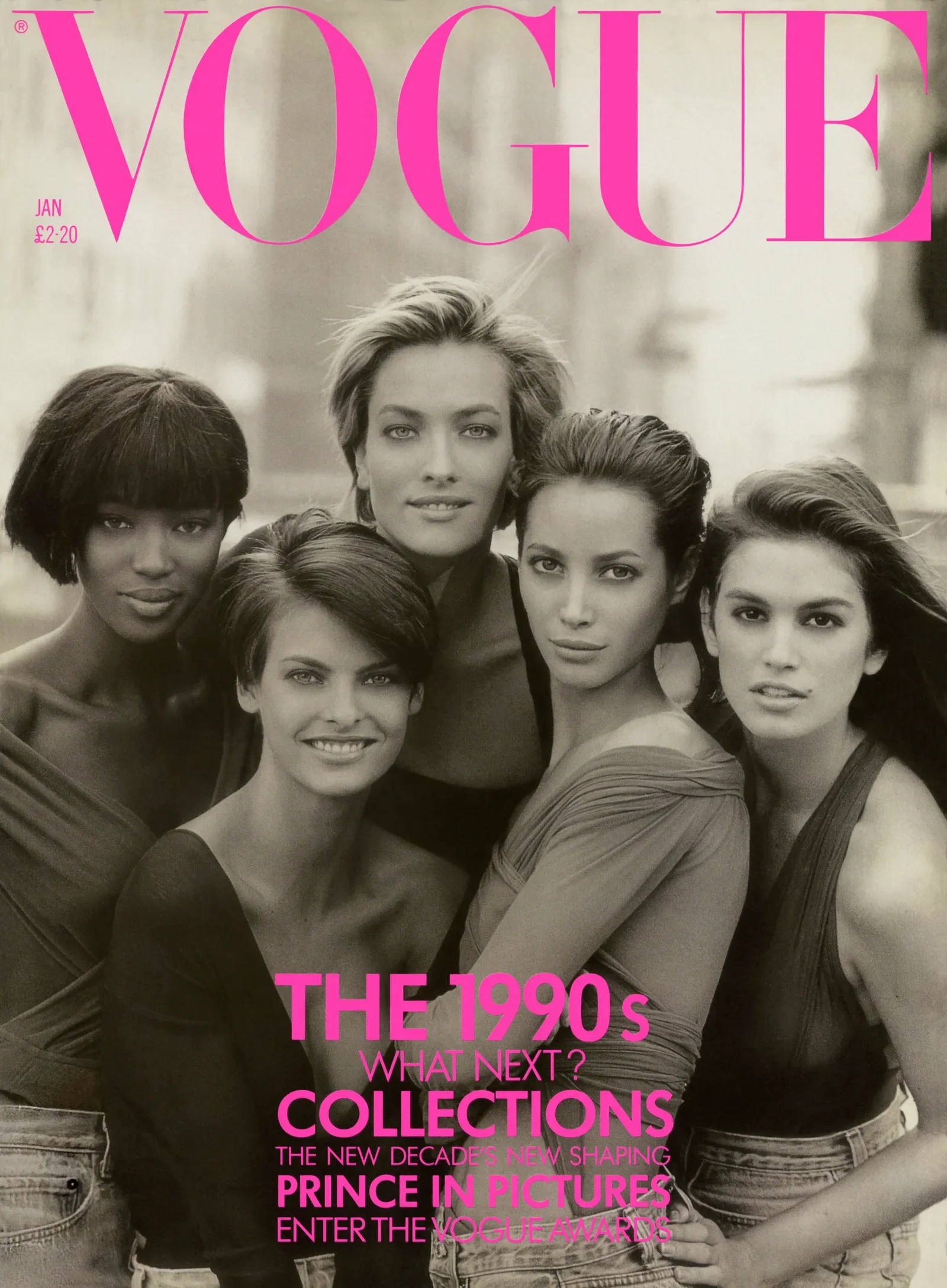The 1990s: The Golden Age of Fashion Photography & Supermodels
Fashion photography in the 1990s marked a pivotal shift in the fashion industry. This decade saw the rise of the supermodel era, which had emerged in the late 1980s and extended into the early 2000s. Iconic figures like Cindy Crawford, Naomi Campbell, Linda Evangelista, Christy Turlington, and Tatjana Patitz dominated runways and editorial spreads, becoming the faces of global fashion campaigns. These supermodels were not just models—they were celebrities and cultural icons whose influence reached far beyond the fashion world. Their images were everywhere—they filled fashion magazines, billboards, advertisements, and even music videos, shaping the visual language of the decade.
A defining moment came in 1990 with George Michael’s legendary music video "Freedom! ’90," directed by David Fincher. It featured five of the biggest supermodels previously mentioned—lip-syncing to the lyrics: a celebration of their beauty, their glamour, and fashion’s growing fusion with pop culture.
During this time, fashion photography evolved significantly. No longer limited to showcasing garments and accessories, it became a powerful tool for storytelling and self-expression. Photographers used their work to convey attitude, personality, and cultural context, transforming fashion editorials into striking visual narratives that continue to inspire the industry today. They played a vital role in creating this image of supermodels and in shaping the aesthetics and narratives of 1990s fashion, each bringing their own distinctive style and visual language.
Herb Ritts, one of the most influential American photographers of the time, worked with many celebrities and supermodels and created some of the most iconic images of the 1990. He was known for his clean compositions, sculptural poses and high-contrast black-and-white imagery. His portrait “Stephanie, Cindy, Christy, Tatjana, Naomi – Hollywood, 1989” epitomizes 1990s fashion photography: polished, powerful, and instantly recognizable.
STEPHANIE, CINDY, CHRISTY, TATJANA, NAOMI, HOLLYWOOD 1989 | H. RITTS
Jacques Olivar created highly stylized photographs of models like Esther Canadas and Georgina Grenville. His images had a bit of a rock and roll feel to them, and the models looked like they were straight out of a music video, with their strong attitude and personality:
Antoine Verglas, on the other hand, favored a more intimate approach to fashion photography. His portraits of Cindy Crawford, Tatjana Patitz and Claudia Schiffer offered a rare glimpse into their intimacy, far from the glitz and glamour of the fashion industry. Using natural light and minimal styling, Verglas humanized the supermodel capturing vulnerability and strength in equal measure.
These photographs have allowed the supermodels to become more than just images, and to become personalities in their own right:
German photographer Peter Lindbergh rejected the polished perfection of earlier decades in favor of stripped-down realism and minimalism, considered one of the pioneers of the "anti-touch" movement in fashion photography. His preference for simple sets, natural and soft lighting, minimal makeup, and monochrome palettes gave rise to a new standard of beauty: raw, honest, and emotionally resonant.
His seminal work for Harper’s Bazaar and Vogue reflected a more humanistic, story-driven vision of fashion—one that celebrated imperfections and emotional depth over idealized glamor.
Another defining element of 1990s fashion photography was the emergence of unconventional models like Kate Moss, whose waif-like frame and androgynous look challenged the traditional industry standards:
KATE MOSS, HARPER’S BAZAAR, NEW YORK, 1994 | PETER LINDBERGH
At the more subversive end of the spectrum, American photographer Steven Meisel redefined editorial photography with his edgy, often controversial spreads. Known for his bold narratives and theatrical staging, Meisel worked closely with supermodels like Naomi Campbell and Christy Turlington to create images that were often provocative, fashion-forward, and socially conscious. He helped shape the image of the Femme fatale in popular culture. His long-standing collaboration with Vogue Italia became a benchmark for high-concept fashion editorials.
NAOMI CAMPBELL AND CHRISTY TURLINGTON, LOS ANGELES, VOGUE ITALIA, DECEMBER 1989 | STEVEN MEISEL
The 1990s forever changed fashion photography, turning it into a space where fashion, pop culture, and visual storytelling converged. Supermodels weren’t just modeling clothes—they were telling stories, setting trends, and influencing generations of artists and photographers.
From Jacques Olivar’s cinematic stylings to Lindbergh’s minimalist realism, the decade produced a rich diversity of photographic voices. The visual language of 1990s fashion still echoes in today’s fashion campaigns, editorial shoots, and brand aesthetics. Its legacy lives on through countless reinterpretations by contemporary creatives who continue to draw from this powerful, golden era of image-making.
Read also:
1950–1959 The Golden Age of Fashion Photography
The 1960s in Fashion Photography: A Revolutionary Decade
Photography in the 1970s: Color, Counterculture, and Creative Revolutions
The 1980s in Fashion Photography: From Power Aesthetics to Postmodern Grit
Capturing a New Era: Trends that defined Fashion Photography in the 2000s
Discover FAMOUS MODEL IMAGES






